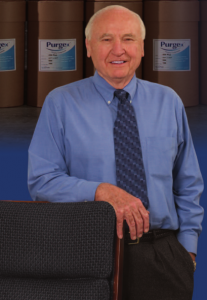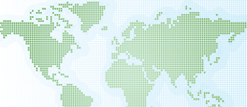PLASTICS INDUSTRY BIOGRAPHY OF ARTHUR P. HAAG FOUNDER OF NEUTREX, INC.

Arthur P. Haag had a 70-year career as a chemical engineer, innovator, and executive in the plastics industry. Haag made major contributions to plastics in two distinct phases of his career. First, between the mid-1950s and 1986, Haag had a leading role in the development, manufacture, and commercialization of titanium and organic catalysts used in the plastics manufacturing industry. Second, between 1992 and his death in 2023, Haag had a leading role in the development, manufacture, and worldwide acceptance of commercial purging compounds as a method for increasing quality and efficiency in thermoplastic molding, therefore increasing productivity and bottom-line profitability in the molding industry.
BACKGROUND
Born in 1929 in Chicago, Illinois, Haag was the youngest son of a German mechanical engineer who immigrated to the United States with his family after World War I. As a child, Haag assisted his father, brothers, and uncles in the family refrigeration business. Haag went on to study Chemical Engineering at the University of Wisconsin at Madison. After his college career was interrupted by a stint with the U.S. Marine Corps during the Korean War, Haag received his BSChE degree in 1953. Haag was later licensed as a Professional Chemical Engineer in both California and Ohio.
“FIRST” CAREER – PRODUCING CATALYSTS FOR PLASTICS INDUSTRY (1953-1986)
Haag began his career as a research and development engineering project manager and plant manager for Stauffer Chemical at Richmond, California, specializing in metals. For many years, Stauffer produced titanium tetrachloride (“TiC14”), which was used for skywriting and smoke screens. During the early Cold War, titanium was a strategic metal needed for advanced jet aircraft and rockets. Haag managed Stauffer’s project to produce titanium metal, which included supervising the building of a semi-works plant.
When a decline in demand for titanium metal threatened to shutter the plant, Montecatini of Italy (later Montedison) inquired if Stauffer could supply titanium trichloride (“TiCl3”) to serve as a ZieglerNatta catalyst for the world’s first commercial isotactic polypropylene plant, which became operational in 1957. (The utility of titanium-based catalysts in the production of plastics was discovered in 1953 by Karl Ziegler in Germany and Giulio Natta in Italy, and they shared the 1963 Nobel Prize for Chemistry for their discoveries in the fields of the chemistry and high polymers technology.) These circumstances thrust Haag into a pioneering role in the production of titanium catalysts, which were difficult to manufacture and very important to the early rapid growth of the polypropylene industry. Haag redesigned Stauffer’s Richmond titanium metal plant to produce hydrogen-reduced TiCl3 and participated in early business development. These efforts enabled Stauffer to supply TiCl3 to Montecatini and the U.S. market during the early years of the polypropylene industry and to contract with licensees such as Avisun (later Amoco) which produced the first impact copolymers in the U.S. starting in 1958.
Choosing to stay on the West Coast with his young family instead of accepting a transfer to Stauffer’s East Coast operations, Haag worked for several California technology companies during the early to mid-1960s while developing his first business venture. In 1966, Haag co-founded PureChem Corporation. Serving as President of the company, Haag co-developed new methods for producing high-purity TiCl3 utilizing Haag-designed special equipment (ball mills, reactors, driers, etc.). Haag was co-awarded four U.S. Patents (and multiple foreign patents) for this work, including:
- S. Patent 3,623,846: Particle Size Control (Titanium Trichloride) granted November 30, 1973.
- S. Patent 3,769,234: Process for Producing Activated Titanium Trichloride – Aluminum Trichloride granted October 30, 1973.
- S. Patent 3,770,656: Process for Producing Titanium Trichloride – Aluminum Trichloride in Controlled Proportions granted November 6, 1973.
- S. Patent 3,770,657: Removal of Titanium Tetrachloride from Titanium Trichloride – Aluminum Trichloride granted November 6, 1973.
These and other innovations were utilized in a TiCl3 plant co-designed and built under Haag’s supervision in Richmond, California. This plant eventually tripled in size and was a primary supplier of titanium catalysts to the burgeoning American plastics manufacturing industry.
In 1970, Haag negotiated the sale of PureChem to Dart Industries (which was then a major conglomerate that owned Rexene Polymer Company, the Rexall drug store chain, Tupperware, etc.). Initially, Haag managed the PureChem division from Dart’s headquarters in Los Angeles. In 1972, Haag was made responsible for consolidating all Dart catalyst operations, including PureChem and Aztec Chemicals (located in Elyria, Ohio). As the President of Dart’s new Catalyst Division (initially based in Elyria), Haag was responsible for the supply of titanium catalysts to the polypropylene and polybutene industries (from PureChem); the building of a new state-of-the-art PureChem production facility at Bayport, Texas; the supply of organic peroxides and peresters to the low-density polyethylene and polystyrene industries (from Aztec); the supply of magnesium catalysts to the Noryl industry (from Aztec); and the research and development of enhanced products, manufacturing methods and equipment, and facility safety programs for the entire division. Although catalyst manufacturing processes involved very hazardous materials and operations, the Aztec plant set a remarkable record for employee and facility safety, including five years without a “lost time” accident. This record was attributable to equipment and procedures installed under Haag’s leadership, and worker acceptance and implementation of special safety training. During Haag’s tenure with Dart, the Catalyst Division was one of the three main producers of catalysts for the American plastics industry. Haag was the recipient of “Best Manager of the Year” and “Top Safety” awards from Dart.
In 1982, Dart sold the Catalyst Division to Phillips Petroleum, and it became a new Phillips subsidiary called Catalyst Resources, Inc. The Phillips executive responsible for the acquisition described Haag as the “king” of the catalyst business segment and wanted him as part of the transaction. Relocated to Houston, Haag continued as the President of Catalyst Resources and maintained its position as an industry leader. During his tenure with Phillips, Haag oversaw the development of multiple new titanium catalysts for the plastics industry.
Haag also procured an exclusive license from Mitsubishi Chemical for a second-generation high-yield titanium catalyst, constructed a new plant at Bayport to produce this “Lynx” catalyst, and successfully introduced the Lynx catalyst to the global market (decades later Lynx was still being produced by BASF). Additionally, Haag expanded Aztec by constructing a new plant at Bayport to produce organic peresters for the polystyrene and low-density polyethylene industries. Haag retired from Phillips in 1986.
HAAG’S RENEWED ENTREPRENEURIAL SPIRIT (1986-1992)
Haag’s retirement was short-lived, as he was soon tempted with exciting new business opportunities. During a six-year period, Haag helped to found, develop, finance and/or lead three high-tech entrepreneurial ventures involving medical diagnostic testing, advanced temperature instruments, and nuclear energy. The later involved an association with Texas A&M University, where Haag consulted with Oliver Murphy, Ph.D. (who many years later joined Neutrex as Technical Director). Ultimately, Haag re-entered the plastics industry when he launched his new discoveries, as outlined below.
“SECOND” CAREER – PRODUCING PURGING COMPOUNDS FOR PLASTICS MOLDERS (1992-2022)
In 1992, at age 63, Haag invented the first Purgex™ purging compound to clean thermoplastics molding machines. To commercialize this proprietary product, Haag founded Neutrex, Inc. and built production and office facilities in Houston, Texas. During the subsequent decades, Neutrex has become recognized as a global leader in the commercial purging compound marketplace. Purgex blends and concentrates are widely used to maximize efficiency and quality at molding facilities producing plastic parts for the automotive, medical, consumer products, electronics, packaging, and other industries where productivity, consistency in color, and composition are critical.
Initially working with a small staff, Haag established a U.S. market for Purgex by personally demonstrating its effectiveness in efficiently removing color, contamination, and black specks, allowing manufacturers to get back to full production more quickly after change-overs and with major cost savings. Haag went on to develop an international market for Purgex. In 2007, Neutrex was awarded the U.S. Commerce Department’s Presidential “E” Certificate for Exports for an “outstanding contribution” to the Export Expansion Program of the United States of America. Haag was honored to have a personal meeting with President George Bush in the Oval Office at the White House. This recognition was repeated in 2013 when Neutrex received the Presidential “E STAR” award from the Obama Administration for success in exporting American-made products.
Over the years, Haag and the Neutrex R&D department have developed a line of Purgex purging compound grades for multiple different molding applications, with continuous improvements derived from a fundamental technical approach and extensive testing in the Neutrex laboratory. Haag greatly enjoyed traveling the globe, including attending plastics conventions, meeting with Neutrex’s international distributors on five continents, and enjoying scenic locations in urban, rural, and wild areas around the world.
In 2021, Arthur P. Haag retired as the President of Neutrex, but continued serving as Chairman of the company’s Board of Directors until his death in 2023, just before his 94th birthday. Haag’s engineering and business legacy continues on at Neutrex, as several of his children are involved in the management of the company.
 English (US)
English (US)  Español
Español  Deutsch
Deutsch  Français
Français  Português
Português  Türk
Türk  中国的
中国的  ภาษาไทย
ภาษาไทย  Malay
Malay 